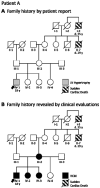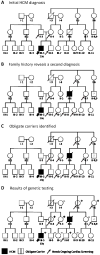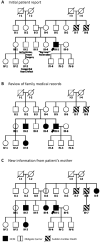A clinical approach to inherited hypertrophy: the use of family history in diagnosis, risk assessment, and management
- PMID: 23424256
- PMCID: PMC3898734
- DOI: 10.1161/CIRCGENETICS.110.959387
A clinical approach to inherited hypertrophy: the use of family history in diagnosis, risk assessment, and management
Figures








References
-
- Watson JD, Crick FH. Molecular structure of nucleic acids; a structure for deoxyribose nucleic acid. Nature. 1953;171:737–738. - PubMed
-
- Hershberger RE, Lindenfeld J, Mestroni L, Seidman CE, Taylor MR, Towbin JA. Genetic evaluation of cardiomyopathy—a Heart Failure Society of America practice guideline. J Card Fail. 2009;15:83–97. - PubMed
-
- Maron BJ. Sudden death in young athletes. N Engl J Med. 2003;349:1064–1075. - PubMed
Publication types
MeSH terms
Grants and funding
LinkOut - more resources
Full Text Sources
Other Literature Sources
Medical

